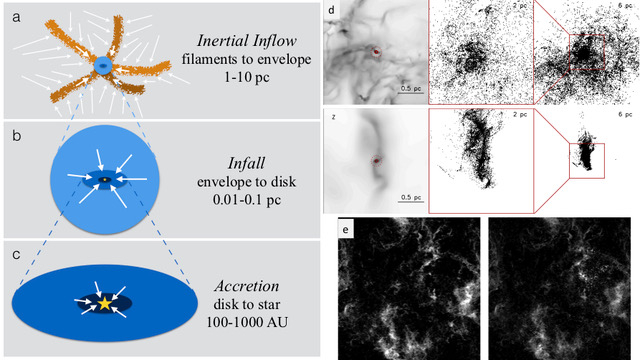| EPoS Contribution |
|
The origin of massive stars: the inertial-inflow model
Troels Haugboelle NBI, Copenhagen, DK | |
| We address the problem of the origin of massive stars, namely the origin, path and timescale of the mass flows that create them. Based on extensive numerical simulations, we propose a scenario where massive stars are assembled by large scale, converging, inertial flows that naturally occur in supersonic turbulence. We refer to this scenario of massive-star formation as the Inertial-Inflow Model. This model stems directly from the idea that the mass distribution of stars is primarily the result of turbulent fragmentation. We quantify the formation mechanism of massive stars by the analysis of a simulation of supernova-driven turbulence in a 250-pc region of the interstellar medium, describing the formation of hundreds of massive stars over a time of approximately 30 Myr. We find that massive stars in general do not form from the collapse of massive cores, nor from competitive accretion, as both models are incompatible with the numerical results. We also compute synthetic continuum observables in Herschel and ALMA bands. Depending on the distance of the observed regions, estimates of core mass based on commonly used methods may exceed the actual core masses by up to two orders of magnitude, and there is little correlation between estimated and real core masses. | |
 | |
| Caption: a-c: Sketch of the mass transport and different important scales in our inertial-inflow model. The infall and disk-accretion scales inherit the filamentary structure of the larger scale but are here depicted as smooth regions for simplicity. d: examples of two stars formed in a cluster (filament) region shown at the top (bottom). The points show the position of Lagranian tracer particles that will later be accreted to the star at the time when the star was formed. Most of the future stellar mass is still distributed over a volume of a few pc when the prestellar core starts to collapse; in particular in a cluster region. e: column density at the end of the simulation over the whole 250-pc volume. The right panel include also the positions of the approximately 3,000 stars more massive than 2.5 Msun. | |
| Collaborators: P. Padoan, UB, ES A. Nordlund, NBI, DK L. Pan, SYSU, CN M. Juvela, U Helsinki, FI |
Key publication
Suggested Session: High-Mass Star Formation |

